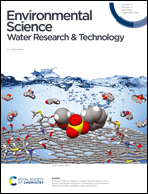Highly efficient removal of phosphate by La–diatomite and sodium alginate composite hydrogel beads
Abstract
Effective phosphorus removal and recovery are crucial for protecting the environment because excessive phosphorus release seriously harms the water environment. To efficiently remove phosphate from wastewater, in this study, a novel hydrogel bead adsorbent (SA-0.4La@De) was synthesized by immobilizing La-modified diatomite with sodium alginate (SA). Adsorption tests showed that phosphate removal by SA-0.4La@De correlated with pH0 of the solution, and SA-0.4La@De performed well in the pH range of 4.0–7.0. The phosphate removal capacity of SA-0.4La@De was maintained in the presence of coexisting ions (SO42−, Cl−, Ca2+ and Mg2+), while it would be significantly reduced in the presence of CO32−. Meanwhile, the adsorption process of SA-0.4 followed the pseudo-second-order kinetic model and the Freundlich model, with a maximum phosphate capacity of 58.9 mg g−1. In particular, SA-0.4La@De exhibited a high phosphate removal efficiency of above 92.5% in actual wastewater experiments. Additionally, the characterization and experimental results demonstrated that electrostatic interactions, ligand exchange, and formation of La–P complexes jointly facilitated the adsorption of phosphate. SA-0.4La@De prepared in this study possesses outstanding phosphate adsorption performance, separability, and low cost, providing a new practical choice for phosphate removal and recovery in actual wastewater remediation.



 Please wait while we load your content...
Please wait while we load your content...